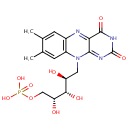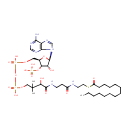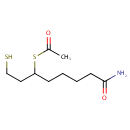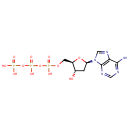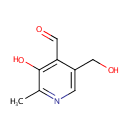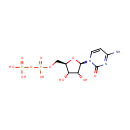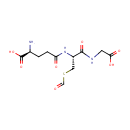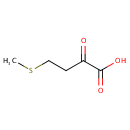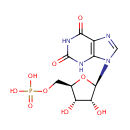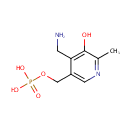
Search Results for compounds
Searching compounds for
returned 4373 results.
Flavin Mononucleotide (PAMDB000408)
IUPAC:
{[(2R,3S,4S)-5-{7,8-dimethyl-2,4-dioxo-2H,3H,4H,10H-benzo[g]pteridin-10-yl}-2,3,4-trihydroxypentyl]oxy}phosphonic acid
CAS: 146-17-8
Description: FMN is coenzyme for a number of oxidative enzymes including NADH dehydrogenase. It is the principal form in which riboflavin is found in cells.
Tetradecanoyl-CoA (PAMDB000409)
IUPAC:
{[(2R,3S,4R,5R)-5-(6-amino-9H-purin-9-yl)-4-hydroxy-2-({[hydroxy({[hydroxy({3-hydroxy-2,2-dimethyl-3-[(2-{[2-(tetradecanoylsulfanyl)ethyl]carbamoyl}ethyl)carbamoyl]propoxy})phosphoryl]oxy})phosphoryl]oxy}methyl)oxolan-3-yl]oxy}phosphonic acid
CAS: 3130-72-1
Description: Tetradecanoyl-CoA (or myristoyl-CoA) is an intermediate in fatty acid biosynthesis, fatty acid elongation and the beta oxidation of fatty acids. It is also used in the myristoylation of proteins. The first pass through the beta-oxidation process starts with the saturated fatty acid palmitoyl-CoA and produces myristoyl-CoA. A total of four enzymatic steps are required, starting with VLCAD CoA dehydrogenase (Very Long Chain) activity, followed by three enzymatic steps catalyzed by enoyl-CoA hydratase, 3-hydroxyacyl-CoA dehydrogenase, and ketoacyl-CoA thiolase. Myristoylation of proteins is also catalyzed by the presence of myristoyl-CoA along with Myristoyl-CoA:protein N-myristoyltransferase (NMT). Myristoylation is an irreversible, co-translational (during translation) protein modification found in animals, plants, fungi and viruses. In this protein modification a myristoyl group (derived from myristioyl CoA) is covalently attached via an amide bond to the alpha-amino group of an N-terminal amino acid of a nascent polypeptide. It is more common on glycine residues but also occurs on other amino acids. Myristoylation also occurs post-translationally, for example when previously internal glycine residues become exposed by caspase cleavage during apoptosis.
S-Acetyldihydrolipoamide (PAMDB000411)
IUPAC:
6-(acetylsulfanyl)-8-sulfanyloctanamide
CAS: Not Available
Description: S-acetyldihydrolipoamide is a member of the chemical class known as N-acyl Amines. These are compounds containing a fatty acid moiety linked to an amine group through an ester linkage. In Pseudomonas aeruginosa the dihydrolipoyl transacetylase component (E2) of the pyruvate dehydrogenase complex catalyzes the reaction of acetyl coenzyme A (acetyl-CoA) with dihydrolipoamide, producing coenzyme A and S-acetyldihydrolipoamide. [PMID: 3101735]
dATP (PAMDB000412)
IUPAC:
({[({[(2R,3S,5R)-5-(6-amino-9H-purin-9-yl)-3-hydroxyoxolan-2-yl]methoxy}(hydroxy)phosphoryl)oxy](hydroxy)phosphoryl}oxy)phosphonic acid
CAS: 1927-31-7
Description: dATP is a special carrier of energy and is the molecule adenosine triphosphate, or ATP. The ATP molecule is composed of three components. At the centre is a sugar molecule, [[ribose] (the same sugar that forms the basis of DNA). Attached to one side of this is a base (a group consisting of linked rings of carbon and nitrogen atoms); in this case the base is adenine. The other side of the sugar is attached to a string of phosphate groups. These phosphates are the key to the activity of ATP. ATP consists of a base, in this case adenine (red), a ribose (magenta) and a phosphate chain (blue). ATP works by losing the endmost phosphate group when instructed to do so by an enzyme. This reaction releases a lot of energy, which the organism can then use to build proteins, etc.
Pyridoxal (PAMDB000414)
IUPAC:
3-hydroxy-5-(hydroxymethyl)-2-methylpyridine-4-carbaldehyde
CAS: 66-72-8
Description: Pyridoxal is the 4-carboxyaldehyde form of vitamin B6 which is converted to pyridoxal phosphate which is a coenzyme for synthesis of amino acids and other compounds.
CDP (PAMDB000415)
IUPAC:
[({[(2R,3S,4R,5R)-5-(4-amino-2-oxo-1,2-dihydropyrimidin-1-yl)-3,4-dihydroxyoxolan-2-yl]methoxy}(hydroxy)phosphoryl)oxy]phosphonic acid
CAS: 63-38-7
Description: Cytidine 5'-(trihydrogen diphosphate) is cytosine nucleotide containing two phosphate groups esterified to the sugar (ribose) moiety.
S-Formylglutathione (PAMDB000417)
IUPAC:
(2S)-2-amino-4-{[(1R)-1-[(carboxymethyl)carbamoyl]-2-(formylsulfanyl)ethyl]carbamoyl}butanoic acid
CAS: 50409-81-9
Description: S-Formylglutathione is formed from the oxidation of S-hydroxymethylglutathione by the enzyme formaldehyde dehydrogenase (FDH; EC 1.2.1.1) in the presence of NAD (PubMed ID 2806555)
2-Oxo-4-methylthiobutanoic acid (PAMDB000418)
IUPAC:
4-(methylsulfanyl)-2-oxobutanoic acid
CAS: 583-92-6
Description: 2-oxo-4-methylthiobutanoic acid is the direct precursor of methional. It is an intermediate of cysteine and methionine metabolism. It is converted to L-methionine via tyrosine aminotransferase. (KEGG)
Xanthylic acid (PAMDB000419)
IUPAC:
{[(2R,3S,4R,5R)-5-(2,6-dioxo-2,3,6,9-tetrahydro-1H-purin-9-yl)-3,4-dihydroxyoxolan-2-yl]methoxy}phosphonic acid
CAS: 523-98-8
Description: Xanthylic acid is an important metabolic intermediate in the purine metabolism, and is a product or substrate of the enzymes inosine monophosphate dehydrogenase (EC 1.1.1.205), hypoxanthine phosphoribosyltransferase (EC 2.4.2.8), xanthine phosphoribosyltransferase (EC 2.4.2.22), 5'-ribonucleotide phosphohydrolase (EC 3.1.3.5), Ap4A hydrolase (EC 3.6.1.17), nucleoside-triphosphate diphosphatase (EC 3.6.1.19), phosphoribosylamine-glycine ligase (EC 6.3.4.1), and glutamine amidotransferase (EC 6.3.5.2). (KEGG)
Pyridoxamine 5'-phosphate (PAMDB000420)
IUPAC:
{[4-(aminomethyl)-5-hydroxy-6-methylpyridin-3-yl]methoxy}phosphonic acid
CAS: 529-96-4
Description: Pyradoxamine 5' phosphate or Vitamin B6 is a water-soluble compound that was discovered in 1930s during nutrition studies on rats. The vitamin was named pyridoxine to indicate its structural homology to pyridine. Later it was shown that vitamin B6 could exist in two other, slightly different, chemical forms, termed pyridoxal and pyridoxamine. All three forms of vitamin B6 are precursors of an activated compound known as pyridoxal 5-phosphate (PLP), which plays a vital role as the cofactor of a large number of essential enzymes.Vitamin B6 is a water-soluble vitamin. The three major forms of vitamin B6 are pyridoxine (also known as pyridoxol), pyridoxal, and pyridoxamine, which are all converted in to pyridoxal 5-phosphate (PLP) a cofactor in many reactions of amino acid metabolism. PLP also is necessary for the enzymatic reaction governing the release of glucose from glycogen.
